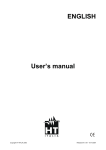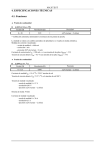Download GP-1 Earth Tester Ground Probe Product Manual
Transcript
AMPROBE ® GP-1 EARTH TESTER GROUND PROBE ™ User’s Manual Amprobe thanks you for purchasing the GP-1. For your safety, please read this instruction manual in its entirety. Part No. 947749 revA 7/2000 ! SAFETY PRECAUTIONS & WARNINGS 1.Read this manual in its entirety before proceeding with any testing. 2.This equipment should only be used by trained professionals who are familiar with electrical hazards. 3. Wear lineman gloves at all times. 4.This unit has been designed and tested for user and instrument protection up to 600VAC maximum. Any application, or misapplication, of voltages exceeding 600VAC to any part of this unit may result in instrument circuit damage and/or lethal electrical shock. 5.Never isolate an earth ground electrode until you have confirmed that there is no voltage present and there is less than 50mA of current flowing through it. Page 2 Table of Contents Instrument Description . . . . . . . . . . . . . . . . . . . . . . . . . . . . . . . . . . . . . . . . . .4 Items Affecting Ground Electrode Resistance . . . . . . . . . . . . . . . . . . . . . . . . .4 Memory Storage Control . . . . . . . . . . . . . . . . . . . . . . . . . . . . . . . . . . . . . . . . .5 Soil Resistivity Test A (Wenner Method) . . . . . . . . . . . . . . . . . . . . . . . . . .6, 7, 8 Two Point Ground/Earth Continuity Test B . . . . . . . . . . . . . . . . . . . . . . . . . . . .9 Electrode Resistance Test C & D . . . . . . . . . . . . . . . . . . . . . . . . .10, 11, 12, 13 Conclusion . . . . . . . . . . . . . . . . . . . . . . . . . . . . . . . . . . . . . . . . . . . . . . . . . .14 Voltage Measurement . . . . . . . . . . . . . . . . . . . . . . . . . . . . . . . . . . . . . . . . . .15 Battery Replacement . . . . . . . . . . . . . . . . . . . . . . . . . . . . . . . . . . . . . . . . . . .16 Field Survey Data Sheet . . . . . . . . . . . . . . . . . . . . . . . . . . . . . . . . . . . . . . . .17 Specifications . . . . . . . . . . . . . . . . . . . . . . . . . . . . . . . . . . . . . . . . . . . . . . . .18 We recommend the user be equipped with the following items to be fully prepared to perform tests: • LINEMAN’S GLOVES (to be worn at all times). • A NON-METALLIC, 100 FT. TAPE MEASURE TO CORRECTLY SPACE THE TEST RODS. • CALCULATOR TO CALCULATE PROPER TEST ROD DISTANCES. • A 3 LB. HAMMER TO POUND TEST RODS IN HARD SOIL. • WATER TO TREAT SOIL AROUND TEST RODS (if necessary). • A CLEAN CLOTH TO CLEAN RODS AND INSTRUMENT AFTER USE. Page 3 Instrument Description View of Instrument Controls Battery Cover Control Panel (see next page for details on control panel) Test lead/cable input ports RS-232 output port Power ON/OFF Fuse/Fuse Holder Function selector switch START button Liquid Crystal Display Battery Cover Screw ITEMS AFFECTING GROUND ELECTRODE RESISTANCE The soil’s ability to conduct current is dependent on the following: 1.The amount of moisture in the soil 2.The quantity of electrolytes 3.The type of electrolytes 4. Adjacent conductors 5. Temperature 6. Electrode depth 7. Electrode diameter 8. Electrode(s) spacing distance All these factors must be considered when designing an adequate or required ground system. Page 4 Memory Storage Control View of Control Panel METER/ FEET SELECTOR button CLEAR button DISTANCE SELECTOR button RECALL button SAVE button SAVE all test results, excluding voltage, can be saved into memory by pressing the SAVE button. Each time the SAVE button is pressed, the next consecutive memory location is displayed and the information is saved to that location. The RECALL button works in conjunction with the function switch. When the RCL button is pressed, “mem” and the last memory location will be displayed, followed by the value, in that location for the test designated by the function switch. Continuing to press the RCL button will allow the prior measurements and locations to be displayed. The CLEAR button has three functions: 1) To clear past memory location (before any other button was pressed or function changed after saving). After the SAVE button has been pressed, press the CLEAR button to clear the last memory location. After pressing the CLEAR button, the cleared memory location will be displayed followed by clr. 2) To CLEAR all memory locations. With the function switch in Test A, B, C, or D, press the CLEAR button to clear all memory locations. After the CLEAR button is pressed, clr will flash and “mem” will be displayed. Press the CLEAR button a second time to conclude memory clearing function. clr will be displayed for approximately 5 seconds, followed by the three dashes. 3) To clear all memory locations and reset two point calibration. With unit OFF, press and hold the CLEAR button, then turn the unit ON. ES will be displayed followed by the three dashes. All memory locations will be cleared. If a two point (Test B) is to be performed, the unit must be calibrated (nulled) prior to the test. To verify that all memory locations have been cleared, switch the function switch to Test A, then press the RCL button. no mem will be displayed followed by three dashes. Repeat for Test B, C and D. Page 5 Soil Resistivity Test: Test A (Wenner Method) Test lead/cable input jacks Function selector switch 1) Turn the FUNCTION switch to Soil Resistivity (see drawing below). BLACK GREEN C1 P1 RED P2 BLUE C2 2) Connect the four test cables to C1, C2, P1 and P2 input jacks (as indicated in drawing above). Please note color codes. 3) Insert four test rods in the ground, equally spaced from each other, using preset distance values in tables on following page. Page 6 Soil Resistivity Test: Test A Tables (cont’d.) GP-1 PRESET DISTANCE VALUES IN FEET AND INCHES Depth of the electrodes Distance between electrodes 2” 3’ 3” 5’ 4” 7’ 6” 10’ 9” 15’ 1’ 20’ 1’6” 30’ 2’0” 40’ 2’6” 50’ 3’0” 60’ 3’6” 70’ 4’0” 80’ TABLE 1 GP-1 PRESET DISTANCE VALUES - METRIC SYSTEM Depth of the electrodes Distance between electrodes 5 cm 1 meter 10 cm 2 meters 15 cm 3 meters 20 cm 4 meters 30 cm 6 meters 40 cm 8 meters 50 cm 10 meters 65 cm 13 meters 80 cm 16 meters 95 cm 19 meters 110 cm 22 meters 125 cm 25 meters TABLE 2 Page 7 Soil Resistivity Test Test A (cont’d.) METER/ FEET SELECTOR button CLEAR button DISTANCE SELECTOR button RECALL button SAVE button Function selector switch Control Panel 4) Referring to Table 1 or 2 (on previous page), press the DIST button to scroll through the preset values until the appropriate distance is displayed. Each time you perform a test and change the distances, you must go through the same steps. 5) To change distance in meters, or feet, press the m/ft button. “m” will be displayed if meters are selected.Then press the DIST button to scroll through the values until the appropriate distance is displayed. Repeat process above if distance is being measured in feet. 6) Push and hold START button until a result is displayed, then release. Whether you select the distance in meters or feet, the value will be displayed in ohmmeters. Record the value on paper, or save it to memory by pressing the SAVE button. 7) To view the measured resistance from which the GP-1 calculated resistivity from, turn the selector switch to TEST D: SOIL RESISTANCE, and push and release the START button. Record the value on paper or save it to memory by pressing SAVE button. Page 8 2-Point Ground/Earth Continuity Test B NOTE: To measure ground rod resistance accurately, use test C & D instead of B! It is necessary to familiarize yourself with the meter before doing the Two Point Measurement Test B. Calibration is required for this test only. 1) Insert two of the desired test leads or cables into the instrument in C1 and C2 jacks. 2) Short the leads together. 3) Turn the GP-1 power ON. 4) Turn the GP-1 selector switch to Test B: GROUND/EARTH CONTINUITY. 5) Press SAVE button (“k” will be displayed). 6) Push and release the START button The display will remain blank for approximately five seconds. The resistance of the test leads will then be displayed for another five seconds and finally, the unit will null and display .00Ω. The maximum, resistance of test leads that the GP-1 can nullify is five ohms. The instrument will remain calibrated until the batteries are discharged or replaced. 7) Disconnect the short from the test leads and apply the test leads to the circuit under test. 8) Press the START button until a stabilized result is displayed, then release. The display will go blank and then display the measurement of resistance in ohms (Rg). Note the value of Rg or press the SAVE button.The value of Rg will be saved to the next available memory location. Note the memory location. Page 9 Electrode or Grid System Resistance:Test C & D Warning: The power must be turned OFF, the electrode must be isolated from the utility ground, building steel, or any other ground, in order for the GP-1 to correctly measure the resistance value of an earth ground electrode (Test C). Before isolating the electrode under test, verify that power is OFF by: • Measuring the voltage from the grounding conductor to a reliable earth ground. Use the voltmeter measurement feature on the GP-1 (see page 14). • Measuring the leakage current through the electrode using an AMPROBE Model DLC-100, or equivalent, Digital Leakage Current Clamp. Warning: If more than 50ma of current is flowing through the electrode, do not isolate the ground electrode until the source of current is located and turned OFF. The following instructions outline the typical approach to perform a test using the “fall of potential” or 62% method. 1) Switch the GP-1 to Test C “Earth Resistance” 2) Noting color codes, connect the four test cables to the input jacks of the instrument. 3) Connect the BLACK (C1) and GREEN (P1) test cables to the isolated electrode under test. 4) To determine the distances from the electrode in which to drive the tet rods, use the formula on Page 11. Page 10 Electrode Resistance: Test C & D (cont’d.) Calculate distances between the test rods using formula below: C2 = (Depth of the electrode or diagonal of the grid system) x 4 FORMULA 1 P2 at 52% = C2 P2 at 62% = C2 P2 at 72% = C2 0.52 * 0.62 * * 0.72 For example: To test single 10’ deep electrode use following formula: C2 = 10’ x 4 = 40’ P2 at 52% = 40 P2 at 62% = 40 P2 at 72% = 40 = 21’ * 0.52 0.62 = 25’ * * 0.72 = 29’ Note: Inside the top cover of the GP-1 you will find a simplified formula which uses 100 ft. or longer distance for electrode C2. This formula holds in most cases, however, in order to get the most accurate measurements we recommend that you use the formula from this manual. BLUE RED BLACK C1 GREEN P1 P2 at 52% P2 at 62% P2 at 72% C2 at 100% 5) Clip the BLUE test cable (C2) to the 100% test rod and clip the RED (P2) test cable to the test rod at the 62% mark. 6) Turn the GP-1 ON. 7) Press the START button until a stabilized result is displayed, then release. Page 11 Electrode Resistance: Test C & D (cont’d.) 8) The possible results are as follows: • If the test rods are making good contact with the soil, all connections are correct, and the actual value is less than 2kΩ, the measured value (RG) will be displayed in ohms (Ω). Continue to Step 9. • If the test rods are making good contact with the soil, all connections are correct, and the actual value is greater than 2kΩ, “o.r.” (over range) will be displayed. Recheck connections, verify rod to soil continuity and treat if necessary, and/or use longer test rods. 9) Note the value of Rg, or press the SAVE button.The value of Rg at P2@67% will be saved to the next available memory location. Note the memory location.This is your electrode or grid system resistance. BLUE RED BLACK GREEN P2 C2 C1 P1 52% 62% 72% 100% Perform next steps to assure accuracy of the measurements 10)Remove P2 (RED) from the 62% rod and clip to the 52% rod. 11)Press and release the START button. 12)Note the value of Rg, or press the SAVE button.The value of Rg will be saved in the next available memory location. Note the memory location. Page 12 Electrode Resistance: Test C & D (cont’d.) BLUE RED BLACK GREEN C1 P2 C2 P1 52% 62% 72% 100% 13)Remove P2 (RED) from the 52% rod and clip to the 72% rod. 14)Press and release the START button. 15)Note the value of Rg, or press the SAVE button.The value of Rg will be saved to the next available memory location. Note the memory location. 16)The electrode resistance is equal to point P2 @62%. Points P2 @52% and P2 @72% are used to confirm the accuracy of the measurements. The rule of thumb is that in order to perform an accurate measurement, the difference in resistances between points marked as P(62%) and P(52%) as well as between points P(72%). To compute differences use following Formula 2: Formula 2 (P2 @62%) - (P2 @52%) x 100% < ± 10% (P2 @62%) (P2 @72%) - (P2 @62%) x 100% < ± 10% (P2 @62%) Page 13 If results on Page 13 are more than 10%, electrodes must be moved farther apar t (20% - 30% of the distance) and you must retest. If the change of resistance values measured between the rods is less than 10%, the resistance value from the point P2 @62% rod is the value of the earth ground resistance. Explanation: An auxiliary electrode P2 should be outside of the effective resistance areas of both the existing ground electrode and the auxiliary electrode C2 as shown on the Drawing 1. In this case the resistance differences calculated using For mula 2 would be less than 10%. Value P2 @62% is the resistance of the ground rod. If the effective resistance areas overlap, Drawing 2, the resistance differences calculated using Formula 2 would be more than 10%. In this case value P2@62% contains error and cannot be used as a value of the electrode ground resistance. Conclusion It is recommended to repeat the test at 180 degrees from the initial test. The average of both values, measured at the P2/62% mark will give you the average earth ground resistance. If you cannot test at 180 degrees, then test at 90 degrees. If the two measurements greatly vary from each other, then it may be wise to perform a third and, possibly, a fourth test. As an additional test, continue to move electrodes in cross effect (see drawing at right). This is a good way to check the accuracy of the tests. Existing ground rod Page 14 Directions recommended for placing testing electrodes to obtain better accuracy of measurements. Voltage Measurement Warning: Do not attempt measurement of voltages above 600 VAC or circuit damage and/or electric shock may result. Voltage measurement must be made with test leads in C1 and C2 with the function switch in the voltage position only. See seperate software manual for download information. For software updates refer to Amprobe’s website www.amprobe.com 1) Insert the test leads into C1 and C2. 2) Move the function switch to Voltage. 3) Turn the GP-1 ON. 4. Test for AC voltage. Page 15 Battery Replacement When batteries need to be replaced, “BAT” will be displayed on your unit. • Turn the GP-1 power OFF. • Remove the test leads from the test lead/cable input ports. • With a screwdriver, unscrew the battery cover screw by turning counterclockwise. • Install 4 “D” size alkaline batteries. Amprobe Model MN-1300 or equivalent. Note position of battery symbols in holder. View of inside battery cover • Replace battery cover and battery cover screw. Note: All memory will be lost if batteries are removed. Download memory or record values before replacing batteries. Two point calibration must also be performed after battery removal. LIMITED WARRANTY Congratulations! Your new AMPROBE instrument has been tested by qualified factory technicians according to the long established standards of AMPROBE INSTRUMENT. You will find it to be of superior quality and craftsmanship and that this product contains the best in components and workmanship. AMPROBE is pleased to extend you a limited warranty against defective materials, and/or workmanship for a period of one (1) year from the date of purchase, provided that, in the opinion of the factory, the instrument has not been tampered with or taken apart. Should your instrument fail due to defective materials and/or workmanship, during the one year warranty period,return it along with a copy of your dated bill of sale. Your bill of sale must iden tify this instrument by model number and serial number. For your protection, please use the instrument as soon as possible. If damaged, or should the need arise to return your instrument, it must be securely wrapped (to prevent damage in transit) and sent prepaid via Air Parcel Post insured or U.P.S. where available to: Service Division Miami, Florida Telephone: 305-423-7500 Fax: 305-423-7554 Outside the U.S.A.the local Amprobe representative will assist you. Above limited warranty covers repair and replacement of instrument only and no other obligation is stated or implied. For Technical Support on this or any Amprobe product call: 1-800-327-5060 Page 16 Field Survey Data Sheet Date: Location: Soil Condition WET DAMP DRY MEMORY GRID TEST TYPE DISTANCE OHMS OHM LOCATION TYPE METERS 1 2 3 4 5 6 7 8 9 10 11 12 13 14 15 16 17 18 19 20 21 22 23 24 25 26 27 28 29 30 31 32 33 34 35 36 37 38 DIRECTION N/S/E/W Page 17 Specifications RESISTANCE Range 0 - 19.99Ω 20.0 - 199.9Ω 200 - 1999Ω Accuracy: RESISTIVITY Range 0-19.99Ωm 20.0-199.9Ωm 200-1999Ωm 2.00k - 19.9kΩm 20.0k - 199.9kΩm 200k - 314 Ωm Accuracy: Resolution 0.01 0.1 1 +/- (2% of reading + 2 Digits) Resolution 0,01 0.1 1 10 100 1000 +/- (2% of reading + 2πa.0.02Ω); where ρ ≤19.99Ω 2πa +/- (2% of reading + 2πa.0.2Ω); where 19.99Ω < ρ ≤199.9Ω 2πa +/- (2% of reading + 2πa. 2Ω); where 19.99Ω < ρ 2πa Test current: Test Frequency: <10mARMS sine wave 135 Hz+/- 1Hz VOLTAGE Range: 0-600VRMS max +/- (2% of reading + 2 Digits) INCLUDED ACCESSORIES Model GP-CS” Model GP-MR Model GP-TL Model GP-RS232 Model GP-BP Download Software GENERAL Fuse: Input Power: Display: Weight: Dimensions(WxHxL): Nominal Temp. Range: Working Temp. Range: Storage Temp. Range: (1) 30’(10m) Green test cable (1) 30’(10m) Black test cable (1) 47’(15.5m) Red Test cable (1) 77’(25.5m) Blue test cable (4) 9”measuring rods (1) Safety banana test lead set (1) 9 pin male to 9 pin female-RS-232 cable (1) Black shoulder pouch 5 x 20mm, 32mA @250V fast blow, Amprobe Model 5 x 20-250.32 (4) “D” cells, Amprobe Model MN-1300 3-1/2 Digit L.C.D. 3/4”(H) 7.26 lbs. (3.3kg) 13.6”x5.1”x9.8” (3.45Cm x 13Cm x 25cm) 41 - 95°F (5 - 35°C) 32 - 104°F (0 - 40°C) 14 - 140°F (-10 - 60°C) STANDARDS Constructed according to: Ground resistance measurement: Radio frequency emission Radio frequency immunity Page 18 EN61010-1 VDE 0413 Part 7 EN50081-1 EN50082-1 Class B Page 19 Miami, Florida Telephone: 305-423-7500 • Fax: 305-423-7554 www.amprobe.com

































